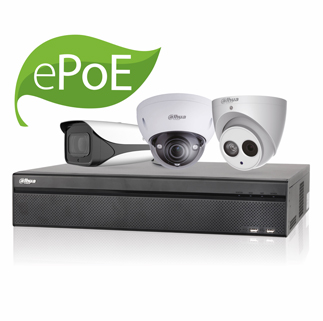Dahua Technology has launched a range of extended Power over Ethernet (ePoE) cameras, network switches and network recorders (NVRs). The product firm says these enable installers to go beyond usual transmission distances.
The ePoE IP products support up to 800m between camera and network switch or NVR. According to the company, this solution overcomes the limitations of traditional Ethernet and PoE, which restrict cable runs between network ports to 100m. This eliminates the need for Ethernet extension units and intermediate repeater network switching.
These products are for analogue-to-IP migration involving IP video, audio, control and power (four-in-one) transmission over coax cable using an ePoE-BNC adaptor. Dahua has developed cameras using the new approach, covering resolutions from 1080P to 4K in many formats, including box, bullet, dome and eyeball. Varifocal and fixed lens types can meet most project requirements.
The ePoE series has been developed from Dahua’s eco-savvy 3.0 portfolio and inherits Smart Video Detection (tripwire, intrusion, abandoned/missing detection), as well as facial recognition and Smart H.265 encoding. The ePoE network recorders have eight green ePoE ports that support long-distance PoE transmission. There are three models with 2/4/8 SATA ports for differing storage needs.
System migration
Dahua has deployed a H.265 chipset to support 4K and H.265 decoding, with performance of up to 16 channels at 1080P, or four channels at 4K as live view or playback. As a sub-category of the company’s Pro series NVR, the ePoE NVR inherits Smart Video Detection, Smart H.265, ANPR (automatic number plate recognition) and point of sale (POS) monitoring. It can work with standard Ethernet or PoE cameras and switches, allowing for system migration and hybrid systems.
The ePoE network switch has four ePoE ports that provide transmission distances of 300 metres at 100 Mbps or 800m at 10 Mbps/EoC when connected with ePoE cameras. The switch supports plug & play and no additional configuration is required to achieve exceptionally long transmission distances. There is also robust protection against lightning strikes and surges, which avoids the need for additional equipment and costs. The switch will even work with non-ePoE cameras, offering transmission of 100 metres at 100 Mbps.
Fewer points of failure
These new ePoE devices have many applications, but are the manufacturer says suited for perimeters found at warehouses, car parks, shopping centres, factories, science parks and critical national infrastructure (CNI). Dahua achieves economies for the installer and the end-user by avoiding the use of repeater devices and the related power supplies and junction boxes that are necessary with conventional approaches to long cable runs. Fewer units means fewer points of potential failure; while use of fibre optic transceivers on long-distance transmission would mean a power supply is required for the transceiver and camera.
Dahua has simplified network structure, as only one cable is required to connect front-end to back-end devices. This means higher reliability, streamlined installation and lower maintenance costs, the firm says. This solution the makers add can reduce the cost of analogue-to-IP migration and give the integrator a greater range of options.










